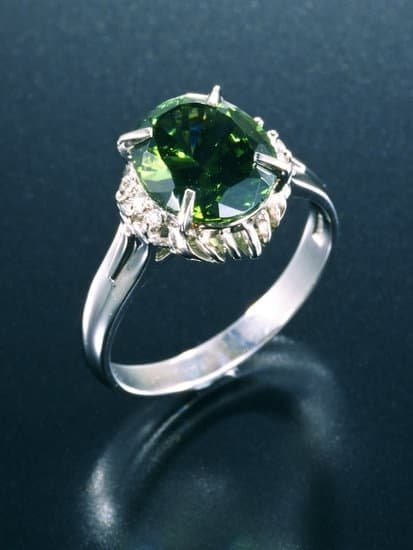Markings on gold jewelry indicate the quality and authenticity of gold jewelry. Each country has their own markings relative to the geographical region they are from, as well as specific makers’ marks, and karat counts if desired.
The presence of a marking atop a piece of gold jewelry isn’t an indication that it is real gold, but rather an indication that it was tested by an institution or professional for purity. Certain jewelsmiths will hallmark pieces with beautiful engravings and inscriptions, all with presumably small details will guarantee its authenticity.
Not All Gold Jewelry Has Markings However, not all gold jewelry has markings. Generally speaking, many jewelers will only produce hallmarked jewelry over a certain purity level.
However this is not always the case in countries such as China where mass-produced items made from lower-quality metals are sold without any external authentication or signature markings on them at all due to the cost and time taken to add these markings being too costly for what is essentially disposeable fashion jewellery. Also some ancient pieces may have gone through centuries of wear and tear distroying any markers that may have been present originally.
The Benefits Of Gold Markings The benefit of having markings on your gold jewelry lies in its ability to showcase authenticity when shopping for novel pieces. Any trained service professional who sees a marking can then confidently determine whether said marking matches up with accepted industry standards or not – immediately changing the price, accessibility and authenticity of the item itself and allowing customers to make well educated purchases they feel secure about investing in.
Another great factor regarding markings is customs officials, insurers or policemen who can easily prove stolen jewels belonged to a victim upon seeing them being move around due to identifying quality factors including karat numbers or identification numbers embedded into each individual piece; something which only applies when pieces are deeply inscribed with official hallmarks before sale/movement across territories or borders.
Overview of Gold Jewelry Markings
Gold jewelry markings are a way to identify whether certain pieces of jewelry are genuine gold or not. Many countries have laws that require merchants to clearly mark the purity of gold jewelry, with the karat listed as a number or abbreviation.
This ensures that customers can be sure of the level of quality they are receiving when purchasing an item of gold jewelry. Additionally, gold buyers often look for markings on jewelry to help determine its value before making a purchase.
What Kinds Of Markings Are Common?
The most common type of markings are stamps that indicate the purity or karat weight of a given piece, such as “14k”. Depending on the country, certain letters may also be used to denote various types of alloys in the metal, and many jewelers will assign their own unique identifying marks as well.
European countries usually adhere to numeric symbols such as “585” in order to define the percentage brass and copper alloyage in each piece. Additionally, some countries may include anything from Hallmarks denoting where an item was made or assayed, to maker’s marks indicating who crafted it.
Are All Gold Jewelry Items Marked?
No, not all pieces will have visible markers due to age, plating techniques or wear and tear over time causing them to fade away; however, some countries may still require jewelers to stamp small marks internally within items instead.
Furthermore, there may still be a few merchants who choose not to abide by legal regulations and create unmarked pieces anyway; one should always check for signs like hallmarks or serial numbers just as another measure before buying an item of gold jewelry.
Finding the Right Markings For Different Types of Gold Jewelry
When shopping for gold jewelry, it’s important to understand the type of markings that indicate how pure and valuable the pieces will be. Depending on the type of gold used in the piece, there should be a special stamping or hallmark identifying it as 14, 18 or 24 karats. These markings not only establish purity but can also help buyers determine the value and retail cost of their purchase.
In terms of understanding what kind of jewelry marking is appropriate for each kind of gold available, here are some key points to remember:
- 14K Gold – This type of gold is stamped with a number “14” followed by either “K” or “karat.” It contains 58.3% pure gold.
- 18K Gold – This type is marked with an “18” from which follows either a “K” ore a “karat.” It contains 75% pure gold.
- 24K Gold – This one is highly valuable due to its higher pure grade, Pure 24k.gold carries an additional mark as well as “24K” usually written as 999 (for 99.9%).
Care should be taken when buying lower karat jewelry such as 10k and 12k pieces which have limited resale value because they contain so little actual gold content relative to other styles. Therefore if quality and higher prices are desired, then 14k minimum should be the cutoff considered when making purchasing decisions.
Apart from being marked with karat numbers and grade designators, many pieces also carry brands’ marks that provide details in regards to designers named relevant information about where they were manufactured before being sold commercially. Various international standards now exist that operate in different markets use these brands/hallmarks symbols and letters to inform customers about their authenticity or traceability from source expert retailers.
That way customers can receive quality assurance when making purchases online from established outlets that boast reliable origins and reputations in their respective field/s commodities concerned epected regulatory parties interested in establishing trust & confidence logos business relationships among marketplaces globally.
Understanding the Different Types of Gold Jewelry
Gold jewelry is a timelessly popular choice for nearly any occasion and style. With so many colors, finishes, karats, and weights available, it can be difficult to know which type of gold is best for you. It’s also important to note that all types of gold jewelry can come with or without markings that indicate their authenticity and construction.
What is Gold Jewelry Made of?
Generally speaking, gold jewelry is created using a blend of metals including silver, copper, zinc, and palladium to make various grades of gold. The various karat ratings demonstrate the percentage content of pure gold in the metal-based alloy: 14kt (58%), 18kt (75%), 22kt (91%) and 24kt (100%). Many different pieces are made with 10k or 14k for qualities such as tarnish resistance and durability.
Markings on Gold Jewelry
In addition to its grade or purity grade, all gold jewelry must carry markings stating the official source certification given by respective regulating bodies. These include but are not limited to registering body marks like GIA/IGI certificates; hallmarks from international assay offices; karat weight stamps such as “14K” or “18K”; maker’s marks that identify the manufacturer; serial numbers; etc. The presence of these markings verifies and confirms the quality of the piece.
Gold pieces may also feature unique marks like production codes applied right at the factory during fabrication. These mark pieces as originals from the same manufacturer or supplier thus ensuring consistent high standards across batches/models produced. Pieces offered in bulk quantities may also tumble stamp every piece with their logo for easy identification later down the line in case of sales promotions or special offers by them later on.
Role of Markings in Gold Jewelry
Gold jewelry markings are symbols or stamps that denote specific characteristics of the jewel, such as the carat weight, purity, type of gold alloy used, and the manufacturer. It is important for buyers to note and keep track of these markings prior to purchasing gold jewelry as it will help them determine if a piece is authentic and worth its price.
With many similar pieces of jewelry available on the market today, diamond marking is a helpful way for customers to tell them apart.
Types of Markings
There are various types of markings found on Gold Jewelry; some more common than others. These include:
- Hallmarks – these are geometric shapes or letters that identify the manufacturer or country where the item was made.
- Karat Stamps – these denote the carat purity value (i.e., 18K gold).
- Metal Alloy Entries – these refer to any additional metals besides pure gold that may be alloyed during manufacturing for strength and cost-effectiveness.
- Serial Numbers – Unique codes given by manufacturers so they can keep track of their items in case they need to be identified. May only found in higher end pieces.
What If There Is No Marking?
If there are no visible markings on a particular piece of jewelry then it’s possible it may not be genuine gold jewelry. The absence of any hallmark could mean that either the piece isn’t real or has been tampered with in some way.
To verify its authenticity potential buyers should take it to a reputable local jeweler who has experience with determining genuine gold jewelry from imitations. If necessary, they can also take further steps such as having tests done at a lab to check for quality assurance.
Common Markings Found on Gold Jewelry
Gold jewelry often has markings that indicate its metal purity. 14k gold is the most common type of gold used in jewelry and it carries a mark that reads “14k” or “.585”, which is the European equivalent of “14K”.
18K gold, which is higher quality than 14K but less common, carries a mark that reads “18k” or “.750”. Purity marks are typically located on the inside or outside of the band, although they may be on a decorative element like a clasp.
What Does Handmarking Signify?
Handmarking occurs when a jeweler marks their own work with an engraving tool and indicates the type and purity of the gold. The jeweller will usually use their own name or logo on their handmarked item as part of their unique signature.
It’s important to note these markings can be hard to locate because they tend to be small and difficult to see with the naked eye. However, if you’re able to find them, they can help determine whether or not an item is genuine.
How Are Other Metals Marked?
While different metals such as silver carry hallmarks, indicating they are authentic sterling silver pieces, other metals like stainless steel, titanium, white gold and platinum don’t always have visible marks. In general these materials should have some sort of number code associated with them that identifies what material it is made from as well as its grade or alloy mix.
This code will vary depending on the manufacturer, so research each individual one before making any assumptions about metal grades and purity levels within jewelry pieces without those codes present.
The Significance of Jewelry Marks
Jewelry marks are essential in understanding what type of precious metal has been used in creating a piece and also verifying authenticity when buying items second-hand or from reputable sellers. Knowing this information can impact price (since different metals have different values) as well as resale down the line if needed (as buyers need applicable certificates validating authenticity).
Understanding how different types of metals are marked can make all the difference in finding genuine precious pieces at affordable prices both online and instore.
History of Gold Jewelry Markings
Gold jewelry markings are an indication of the purity and quality of the pieces. In order to assign a purity rating, jewelry makers often use a standard called karatage or hallmarks. This practice has been around since at least medieval times and began as a method for governing authorities to impose taxes on imported goods.
Jewelers would need to show proof that their wares were in compliance with local tax laws by marking them accordingly. Over time, these gold jewelry markings evolved to become part of the industry’s hallmark system, as it is today.
What Do Gold Jewelry Markings Show?
Gold jewelry markings indicate both the purity level of the piece as well as provide assurance of its authenticity. Most markings consist of numbers that indicate the gold content measured by karats (K). Higher numbers mean higher gold contents, so 24K represents pure gold while 14K is slightly less pure at 58.5%.
Additionally, many countries have adopted hallmarking systems that act like seals of approval when it comes to identifying and certifying precious metals for legal and taxation purposes. For example, in Europe, where hallmarking was born, all gold items must be tested sure they meet minimum standards set by each nation’s law before exhibiting certain marks.
How Can You Tell if Your Gold Jewelry Has Markings?
In addition to stamp marks such as “24k”, “14k””,18k” or any combination thereof most pieces will also have one extra mark usually consisting of symbols denoting origin or even manufacturer identity. The easiest way to spot these is by taking a magnifying glass or loupe and examining different areas on the piece for engravings or stamps done during production process.You can also contact your trusted jeweler or bring in the item itself for examination using special assaying equipment.
Finally you may check online databases containing information from all national governing bodies involved in certification and quality control – such results should prove especially helpful when dealing with vintage/antique pieces or those acquired elsewhere which lack proper documentation:
- Check Different Areas Using A Magnifying Glass Or Loupe
- Contact Your Trusted Jeweler Or Take The Piece To Be Examined By Professional Assayer
- Look Up Online Databases Containing Records From Quality Control Governing Bodies
Reasons For and Against Markings on Gold Jewelry
Gold jewelry is a great investment that can not only be enjoyed on a regular basis, but can also be handed down as an heirloom for future generations to enjoy. But what if someone wants to know how much gold is in the piece they have? That’s when markings come in. Knowing whether or not gold jewelry has markings will help people decide if it is worth the investment.
Advantages of Markings
Markings are one way to determine the composition and quality of gold jewelry. Most gold jewelry will have at least some kind of mark that indicates the metal content, such as 14k or 18k.
The karat stamp alone will tell consumers how much pure gold is in the piece – 14k means that it is composed of 58% pure gold while 18k indicates 75%. Other information may also be included such as whether or not gemstones were used and other precious metals that are alloyed with the main metal in order to create different colors.
Knowing what material is contained within a piece of jewelry makes it easier for buyers to make a decision regarding its value and identify any counterfeits. In addition, having markings makes it easier for manufacturers and jewellers to track their inventory and ensures consistent quality across their product lines.
Disadvantages of Markings
On occasion, people might come across unmarked pieces that do not bear any stamps, symbols, or numbers indicating its composition. This could either mean that the piece was crafted by a less-than-trustworthy vendor, so buyers should exercise caution when purchasing unmarked jewelry, especially if they feel like they’re getting something too good for a too-low price.
Additionally, certain classic designs don’t always feature marks since stamped items often appear too modern and clunky. It’s also possible that older pieces simply failed to receive a quality control check or accurate weight appraisals before going out on store shelves.
Without markings, buyers may struggle when it comes time to sell their pieces since no information has been recorded about them aside from an estimated weight and characteristics which are unique after years of wear and tear from use.
This lack of detail could cause difficulty in estimating prices when selling, determining insurance coverage and determining authenticity since there is no solid data detailing original source or craftsmanship details like metal alloy blend percentages or signatures from designers or manufacturers alike.
Pros and Cons of Marking Gold Jewelry
Not all gold jewelry is marked. Sometimes, due to the small size or design of a particular piece, it is too hard to mark with a stamp. A jewelry maker can also choose not to put a stamp on an item they have crafted. Although it may be easier to verify the quality of gold in pieces with markings, lack of marking does not mean that the gold is any less valuable per se.
The pros and cons of marking gold jewelry vary depending on the type and choice of marking used. Having stamped markings on an item can make it easy to authenticate and if done correctly can also add an aesthetic value. For instance, if a piece has both numeric and letter markings – usually known as “Hallmarks” – this can identify the purity of the material as well as who made it and where it was made.
For some larger pieces that are designed in a complex manner such as figurines or 3D artworks, having marks may not be practical or even possible without ruining the design itself. In such cases, relying only on other external sources to determine the authenticity can be beneficial.
Finally, some gold markings may actually reduce its value for collectors who buy antique pieces specifically looking for items without stamps especially since jewelers sometimes enhance gems by replating them with purer substances. Since many antique pieces were not originally marked even though their components may have been higher quality than modern ones produced today, un-stamped items often fetch more money than the newer ones with hallmarks attached at times while still being genuine items from periods past.
Thus it is necessary for buyers and sellers alike to enquire about these specifics before making purchase decisions in order to get products worth their money’s worth as well as prevent instances of fraud taken advantage of through unclear labeling practices during sales activities.
Alternatives For Non-Marked Gold Jewelry
In some cases, jewelry that isn’t marked could still be gold. Gold, being a softer metal, is difficult to engrave so there are other methods of verifying its authenticity. If the piece is hollow, it may have a stamp on the inside that would indicate gold content or purity.
Misaligned prongs or grooved lines around the stone can also signify a lower purity of gold. Alternatively, if you have access to an X-ray machine (or a coupon for one) then the tech can measure any non-metallic inclusions found within the metal itself.
Acid Testing
Another method of determining the authenticity of unmarked gold jewelry is through acid testing. This is a common practice conducted by watchmakers and jewelers alike and requires specialized equipment to perform.
A drop or two of acid will cause certain metals to react differently and leave a black residue on top of older gold pieces. Also known as ‘scratch testing’ this procedure can quickly determine an item’s carat weight but you should never attempt this at home due to potentially hazardous chemicals involved.
Magnet Test
Finally, another simple test you can do on your own time involves magnetism. Unlike genuine gold, counterfeit items are often composed of alloys that contain iron and steel which then reacts to a magnet should it be present in any kind of substantial quantity – proving yet again how marketable 24-karat has become over recent years.
Authentic jewelry won’t move under the influence of magnetism whereas fake items may slide sideways slightly if held close enough; making this an ideal go-to option for any consumers hesitant about spending large sums without first knowing what they’re buying into.
Ultrasound Testing
An ultrasound test creates waves not visible to humans that penetrate through solid objects revealing their internal structures and composition measurements with great accuracy.
This type of diagnostic technology is used in many medical procedures such as monitoring pregnancies or scanning blood vessels for much more accurate readings than mere alternative methods currently available on the market – especially useful when spotting gold plating along brass items usually sold as “18k” instead marking them up even higher prices than their inferred worth may suggest.
Conclusion
Not all gold jewelry has markings. While it is true that most pieces of gold jewelry are stamped with a quality mark that indicates the purity of the gold, it is not a given that all pieces of gold jewelry will have these markings.
In some cases, due to the design or size of the piece, there simply isn’t enough room to fit the stamp. Additionally, other considerations such as how delicate or expensive the piece is may cause jewelers to opt out of putting a stamp on it for fear of damaging or devaluing it.
The process of stamping jewelry also means added labor costs and time in production. This can weigh heavily into a jeweler’s decision to forego marking more intricate or costly pieces of jewelry in order to reduce overall cost and keep prices low for customers.
Another factor could be whether or not a certain item was made for a specific customer-in this scenario, stamping would seem like an unnecessary step as there wouldn’t be any doubt as to who owns said item.
Fortunately, there are also tests which can be performed on un-stamped objects (magnet test, acid test) to determine authenticity without damaging jewels or precious stones set in them. These advance techniques allow jewelers and consumers alike to safely identify the contents of items if no stamp is available.
Anytime you invest in buying gold jewelry, it is highly recommended that you ask your jeweler about verification methods in case you ever need confirmation that what you purchased is genuine 24 karat or 18 karat gold jewelry market.

Welcome to my jewelry blog! My name is Sarah and I am the owner of this blog.
I love making jewelry and sharing my creations with others.
So whether you’re someone who loves wearing jewelry yourself or simply enjoys learning about it, be sure to check out my blog for insightful posts on everything related to this exciting topic!





